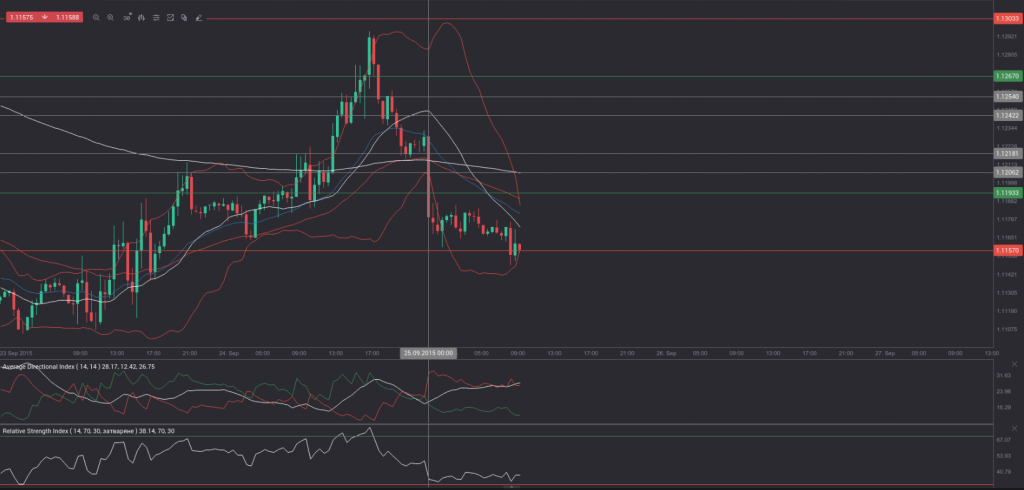Yesterday’s trade saw EUR/USD within the range of 1.1163-1.1296. The pair closed at 1.1230, rising 0.39% on a daily basis, while extending gains from Thursday. The daily high has been the highest level since September 21st, when the cross registered a high of 1.1333.
At 6:51 GMT today EUR/USD was down 0.63% for the day to trade at 1.1162. The pair tested the lower range breakout level (S4), as it touched a daily low at 1.1149 at 6:27 GMT.
Today the cross may be influenced by a number of macroeconomic reports as listed below.
Fundamentals
Euro area
Private Sector Lending
Lending to individuals and business entities in the Euro areas private sector probably expanded a fourth consecutive month in August, rising at an annualized rate of 1.0%, according to market expectations. If so, this would be the fastest annual rate of increase in at least three years. In July the total value of private sector loans increased 0.9% year-on-year. In case lending expanded at a faster pace than anticipated, this might support demand for the euro, as it implies higher economic activity in the future in terms of consumer spending and business investments. The European Central Bank (ECB) is expected to release the official data at 8:00 GMT.
United States
Gross Domestic Product – final estimate
The final estimate of the US Gross Domestic Product probably pointed to an annualized rate of growth of 3.7% in the second quarter of 2015. If so, it would confirm the 2nd GDP estimate, reported on August 27th. The 2nd estimate outpaced the preliminary one, because of higher business spending and faster build up of inventories, according to the Bureau of Economic Analysis.
According to the August 27th report, non-residential fixed asset investment expanded 3.2% in Q2. The preliminary estimate pointed to a 0.6% drop. Investment in non-residential structures rose 3.1% in Q2, while the preliminary estimate pointed to a 1.6% decrease. Equipment investment shrank less than expected, at a pace of 0.4%, compared to a 4.1% drop pointed by the preliminary estimate. The accumulation of inventories in Q2 was revised up to USD 121.1 billion, from the preliminary USD 110.0 billion. This way it contributed 0.22% to growth instead of shedding 0.08% as pointed by the advance estimate. In addition, personal consumption expenditures rose at a faster pace in Q2, 3.1% compared to a preliminary 2.9% increase.
In case the final GDP growth rate exceeded the median forecast by experts, this would cause a strong bullish impact on the greenback. The official data by the Bureau of Economic Analysis are to be released at 12:30 GMT.
Services PMI by Markit – preliminary estimate
Activity in the US sector of services probably slowed down in September, with the corresponding preliminary Purchasing Managers Index coming in at a reading of 55.6. If so, this would be the lowest index reading since June, when the PMI stood at a final 54.8. In August the final seasonally adjusted PMI came in at 56.1, up from a preliminary value of 55.2. The PMI is based on data collected from a representative panel of more than 400 private sector companies, which encompasses industries such as transport and communication, financial intermediaries, business and personal services, computing & IT and hotels and restaurants. Values above the key level of 50.0 indicate optimism (expanding activity). In case, however, a larger-than-projected slowdown in services sector activity was reported, this would have a moderate bearish effect on the US dollar. The preliminary data by Markit Economics is due out at 13:45 GMT.
Reuters/Michigan Consumer Sentiment Index – final estimate
The monthly survey by Thomson Reuters and the University of Michigan may show that consumer confidence in the United States lowered for a third consecutive month in September. The final reading of the corresponding index, which usually comes out two weeks after the preliminary data, probably came in at 86.9, up from a preliminary value of 85.7. If market expectations were met, this would be the lowest level since October 2014, when the gauge of sentiment was reported at a final 86.9. In August the gauge of confidence came in at a final reading of 91.9, down from a preliminary value of 92.9. The survey encompasses about 500 respondents throughout the country. The index is comprised by two major components, a gauge of current conditions and a gauge of expectations. The current conditions index is based on the answers to two standard questions, while the index of expectations is based on three standard questions. All five questions have an equal weight in determining the value of the overall index.
According to preliminary data, the sub-index of current economic conditions, which measures US consumers’ views of their personal finances, decreased to a reading of 100.3 in September from a final 105.1 in August. The sub-index of consumer expectations plunged to a flash reading of 76.4 in September, down from a final value of 83.4 in August. According to survey results, American citizens expect that the inflation rate will reach 2.9% in 2016, up from a rate of 2.8%, as pointed in the August survey.
In case the gauge of consumer sentiment showed a larger decrease than anticipated, this would have a moderate bearish effect on the dollar. The final reading is due out at 14:00 GMT.
Bond Yield Spread
The yield on German 2-year government bonds went as high as -0.234% on September 24th, or the highest level since September 22nd (-0.228%), after which it slid to -0.240% at the close to add 1.2 basis points (0.012 percentage point) on a daily basis, while marking a second consecutive trading day of gains.
The yield on US 2-year government bonds climbed as high as 0.715% on September 24th, or the highest level since September 22nd (0.719%), after which it fell to 0.621% at the close to lose 8.2 basis points (0.082 percentage point) for the day.
The spread between 2-year US and 2-year German bond yields, which reflects the flow of funds in a short term, shrank to 0.861% on September 24th from 0.955% during the prior day. The September 24th yield spread has been the lowest one since August 25th, when the difference was 0.833%.
Meanwhile, the yield on German 10-year government bonds soared as high as 0.622% on September 24th, after which it slid to 0.604% at the close to add 0.006 percentage point compared to September 23rd. It has been the first gain in the past three trading days.
The yield on US 10-year government bonds climbed as high as 2.166% on September 24th, after which it slipped to 2.150% at the close to lose 0.001 percentage point on a daily basis.
The spread between 10-year US and 10-year German bond yields narrowed to 1.546% on September 24th from 1.553% during the prior day. The September 24th yield difference has been the lowest one since September 22nd, when the spread was 1.532%.
Daily and Weekly Pivot Levels
By employing the Camarilla calculation method, the daily pivot levels for EUR/USD are presented as follows:
R1 – 1.1242
R2 – 1.1254
R3 (range resistance – green on the 30-minute chart) – 1.1267
R4 (range breakout – red on the 30-minute chart) – 1.1303
S1 – 1.1218
S2 – 1.1206
S3 (range support – green on the 30-minute chart) – 1.1193
S4 (range breakout – red on the 30-minute chart) – 1.1157
By using the traditional method of calculation, the weekly pivot levels for EUR/USD are presented as follows:
Central Pivot Point – 1.1326
R1 – 1.1439
R2 – 1.1574
R3 – 1.1687
S1 – 1.1191
S2 – 1.1078
S3 – 1.0943






